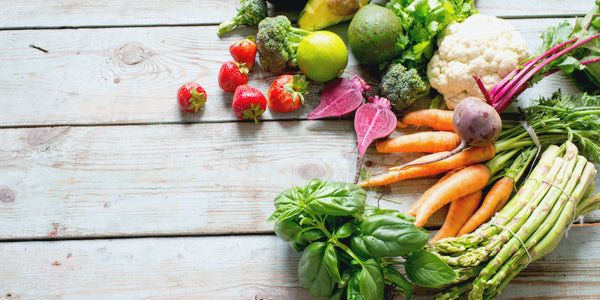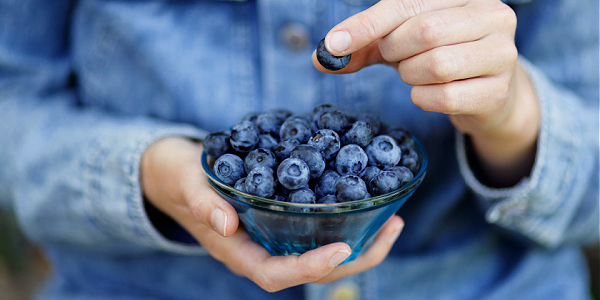
Fruits and vegetables are mainstays in a healthy eating pattern.
While we know to eat them, there are actually fruits and veggies that offer special health properties and benefits.
Learn which fruits and veggies may stand out from the rest and how to include them in a balanced diet.
The Healthiest Vegetables: Nutrition and Health Benefits
Vegetables are naturally low in calories and timeless in a number of nutrients. These include unique phytochemicals, fiber, vitamins, and minerals.
Phytochemicals
Phytochemicals are the active compounds found in plants and offer their color, odor, and flavor. Consuming plants and phytochemicals protect the body's cells against damage and can lower the risks of chronic diseases.
Fiber
Fiber is known to support digestive and heart health, but it can also assist in weight loss and maintenance. People who consume a high fiber diet are more likely to display a lower body mass index (BMI).

Calcium
Mostly known to be sourced from milk and dairy products, calcium is also found in leafy greens and other vegetables. The mineral is well-known for supporting bone health, though it also has roles in muscular, central nervous, and urinary systems.
Folate
Green veggies especially are a significant source of folate, a B vitamin essential for cell production and growth. Folate is also critical for healthy fetal development, helping to develop the brain and spine and prevent major birth defects.
Iron
While iron tends to be sourced from red meats, the mineral is also found in vegetables such as leafy greens and potatoes. Iron is a mineral essential for oxygenating blood and carrying it throughout the body.
Magnesium
Being utilized in over 300 physiological processes, magnesium is imperative for good health. Magnesium is critical for DNA and RNA production, along with roles in bone development, growth, and maintenance.
Potassium
Acting as both an electrolyte and mineral, potassium works with sodium to regulate heart rhythms and muscle contractions. Stroke, osteoporosis, and kidney stone risks have been shown to be reduced as potassium intake rises.
Vitamin A
Mostly known to be in orange carrots, vitamin A is found in vegetables as well. Vitamin A supports normal vision, the immune system, and reproduction.
Vitamin C
Vitamin C offers powerful antioxidant properties to boost the immune system and protect the body. It also works to enhance the absorption of iron.
Vitamin E
Acting as a potent antioxidant, vitamin E helps protect cells against damage and prevent disease described in phytochemicals.
Vitamin K
Vitamin K assists in blood clotting, ultimately preventing excessive bleeding. The vitamin may also prevent bone loss and manage morning sickness linked to cancer.
Healthiest Vegetables for Weight Loss
All vegetables can fit into a balanced diet. However, some should be consumed more than others, especially if trying to lose weight.
This is because vegetables are broken down into "starchy" and "non-starchy" types. Whereas starchy veggies are rich in carbohydrate, non-starchy varieties are low in carb. This naturally influences their calorie content.
Starchy Vegetables
Starchy vegetables are higher in carbohydrates, often 15 grams per serving. Eat starchy vegetables in moderation:
• Corn
• Peas
• Pumpkin
• Zucchini
• Potatoes, including russet and sweet potatoes
Non-Starchy Vegetables
Non-starchy vegetables are generally only 25 calories and five grams of carb per serving. Eat more non-starchy vegetables:
• Asparagus
• Broccoli
• Cauliflower
• Carrots
• Celery
• Cucumber
• Kale
• Lettuce
• Mushrooms
• Onions
• Peppers
• Spinach
Healthiest Fruits for Weight Loss
Fruit is naturally low in fat, sodium, and calories while being ample in phytochemicals. Most commonly sourced nutrients in fruit include dietary fiber, folate, potassium, vitamins A and C.
Eating fresh fruits as part of a balanced, healthy diet can help those losing weight. The filling fiber fruit also assists in weight loss.
High-fiber foods are generally low in calories and tend to be more filling than non-fiber foods. The combination of low-calorie and satiety may facilitate weight loss and/or encourage weight maintenance.
Whereas no fruits should be considered forbidden fruits, there can be too much of a good thing. This is because fruits naturally contain a sugar called fructose, and a high intake of fructose can lead to weight gain.
That being said, pairing with a balanced meal or snack can also lessen the impact of fructose on blood sugar levels. There are additional considerations when selecting fruits and related products. These include fruit juices, ripened fruits, and dried fruits.
Fruit Juices
Fruits should ultimately be consumed in their whole form rather than as juice. Juices are often concentrated with additional sugars and lack fiber.
Greater consumption of fruit juice is associated with a higher risk of weight gain and type 2 diabetes. If you decide to drink a glass of juice, stick to a 4-ounce serving size.
Ripened Fruits
The ripening process can also influence sugar content. Take, for instance, a banana. As it ripens, it becomes less starchy and apparently more naturally sweet.
Sweeter, more ripened fruits are often more readily absorbed. This can cause greater spikes in blood sugar, especially if consumed without a protein or fat source.
Dried Fruits
Dried fruits are concentrated with calories and sugar and raisins are a great example of this. A 1/4 cup of raisins contains 130 calories and is primarily a carb source, supplying 31 grams of total carbohydrate.
On the other hand, you can enjoy 1.5 cups of grapes for only 90 calories and 24 grams of carb! These principles serve true for other dried fruits, including dried cranberries or “Craisins.”

Ultimately, the most importance for enjoying fruit is doing so in moderation. Eating with a protein-based snack or balanced meal can also deter the impact of fructose on blood sugars.
The Healthiest Fruits: Nutrition and Health Benefits
There are many benefits of fruits, especially in their whole form. However, some of the best fruits to eat daily include the following listed below.
1. Blueberries
Blueberries are considered low-glycemic foods, which have a relatively low impact on blood sugar. The berries are rich antioxidants and good sources of dietary fiber, vitamins C and K, manganese, and copper.
Thanks to their lavish nutrient profile, the benefits of blueberries include bowel and heart health. Their anti-inflammatory properties may protect from cancer, too.
There is also compelling evidence regarding blueberries for weight loss. They may influence genes that control fat burning and storing, helping reduce belly fat and even lower cholesterol levels.
2. Raspberries
One cup of raspberries offers a whopping 8 grams of fiber, mostly in soluble fiber form. Raspberries also provide a large amount of vitamins C, E, and K, manganese, folate, iron, and potassium.
Raspberries are considerably known for their polyphenol and anthocyanin content, providing raspberries their rich and vibrant color. They also contain ellagic acid, an antioxidant that has shown anti-cancer properties.
Diabetes management, eye protection, and anti-aging are other properties and benefits of raspberries.
3. Blackberries
Blackberries are high in fiber and a good source of vitamin C. They also are low in calories, carbohydrates, and provide an average of 5 grams of sugar per one cup.
Driscoll's reports fresh blackberries were recently identified as a top cancer fighter. They may also protect the brain from Alzheimer's disease and dementia.
4. Strawberries
Strawberries are not only prime, summertime sweets, but are chock-full of fiber, folate, potassium, vitamin C, and other essential nutrients. Their high phenolic acid content confers not only their vibrant color, but helps manage blood sugar.
Strawberries are also high in the chemicals anthocyanins and ellagic acid. Studies show consuming berries that contain these bioactive compounds may have potential to protect against cancer. They may also aid in the prevention of inflammatory disorders and heart diseases.
5. Lemons
When life gives you lemons, you turn them into health benefits! And the citrus fruit and its juice off many… (Even the smell can awaken the senses!)
According to a study published in the Journal of Nutrition and Metabolism, daily lemon intake may improve blood pressure. Its juice also lends some notable benefits. Other evidence suggests lemon extract warrants potential and future use to treat breast cancer.
Noteworthy benefits of lemon juice include fat loss, boosted immunity, dry mouth and sore throat relief, amongst several others.
6. Guavas
Guava is a tropical fruit supplying dietary fiber, potassium, folate, and some fat-soluble vitamins. The guava leaves are also suppliers of powerful antioxidants.
But the taste is not the only favored characteristic of guava. The fruit may also benefit a number of health conditions, including diabetes and high blood pressure.
7. Cranberries
Cranberries are low in sugar and calories and boast of beneficial nutrients. What's more, the link between American cranberries and health benefits has been an evolving story of 25 years!
Cranberries and its juice are mostly noted for its role in fighting urinary tract infections (UTIs). The anthocyanins, procyanidins, and flavanols in cranberries were all documented to have potential effects on cancer prevention.
The nutrient-dense cranberry also shows promise in maintaining digestive health and protecting from heart disease.
8. Avocados
Avocados are unique in the fact that as fruits are known carb sources, this fruit is rich in healthy fat. Or, more specifically, heart-healthy monounsaturated fats
Avocados are also rich in fiber, potassium, folate, copper, and vitamins B6, C, E, and K.
How Much Fruit & How Many Vegetables Should You Eat?
The USDA's 2015-2020 Dietary Guidelines recommend eating at least two cups of fruit each daily. Paired with eating at least two and a half cups of vegetables, this leads to the general guide of "5-a-day."
Knowing how many vegetables per day likewise depends on calorie needs, health goals, and other factors. However, one should aim to include a veggie with meals and some snacks. How much fruit per day can depend on weight loss goals as well. People attempting to lose weight may limit intake to one to two servings of fruit daily.

Regardless of the individual goal, most Americans struggle to reach their daily fruit and vegetable targets. Naturally increase the amounts of fruit and veggies each day with these tips.
Make a Salad
Add broccoli, cucumbers, snap peas, and other favorite veggie varieties to a salad. Pair with a lean protein source to add flavor depth and substance, along with a heart-healthy, olive oil-based dressing.
Throw into Meals
From eggs, to soups, to casseroles, throw in veggies to offer bulk and extra nutrients without adding a substantial calorie load.
Try New Cooking Techniques
Trying new cooking and heating methods offers diverse flavors. For instance, if not too intrigued by chomping on raw broccoli, try roasting the greens. Preparing veggies with olive or canola oil helps increase the absorption of the fat-soluble vitamins.
Sneak in Sauces
Be sneaky with veggies by throwing them into sauces, including tomato, pizza, and pesto sauces.
Mix into Smoothies
For a nutrient-dense, satisfying smoothie, mix your favorite frozen fruit with a protein source. This may include a protein powder or Greek yogurt.
Mixing green veggies into smoothies is a simple way to increase veggie intake. Simply throw in a handful or two of fresh spinach and mix until the smoothie is smooth.
Besides, at the end of the day, meals and snacks should be balanced with fiber, protein, and healthy fat.
(As well as being enjoyed!)






